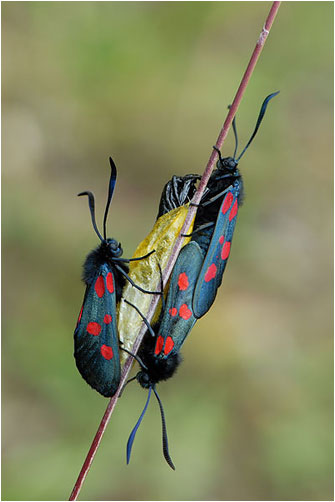|
|
|
Philosophy
|
|
|
There are may ways to approach nature-photography. Many photographers has probably done as I did - finding an interesting location, grapping the gear and then tiptoe around to see what can be found.
This is a very usable method, particularly if you have not yet become a hunter for trophys. When you have used this method for a while, you often get more picky. A Small Tortoiseshell or a Migrant Hawker can no longer keep your attention. Then you start to get engaged. Where do you find the rar butterfly, when does it fly, which flowers does it prefer or which plants are on the menu of the caterpillar?
Now it really gets interesting. Not only does your chances to get the rar species improve, your knowledge about the surrounding nature improves as well. This knowledge will often along with your experience lead you to new questions and new answers and knowledge.
When you are on a hunt for a specific trophy sometimes you forget what it is all about - the IMAGE. It becomes more important to incorporate a new rar species in the collection, than it is to make a great image. The point is to combine both in making a great image of a rar species, but when you at last get in range of the long wanted butterfly or dragonfly, your feel your heart throbbing, your hands start shaking, you forget to check the settings of the camera and just shoot and shoot. It the creature stays put you take a deep breath, check the ISO, shutterspeed and aperture. Hopefully the excitement has now got under control and you begin to think IMAGES again - taking another look in the viewfinder to check the background, is the angel to the creature ok, should a tripod be used and so on.
Ethics and moral
At this point maybe you see that a straw or a twig blocks the view of the insect. Is it okay to remove it? I think yes. A straw can be put down, a twig can be bend aside, but where is the limit? Some could maybe be attempted to bring home the creature and put it in the refrigerator then it will stay put. Maybe even kill it, then you get all the time needed to make an image! Thankfully this methods will be revealed be the unnatural position of e.g. antennae. If you use such methods you are not worthy to be called a nature-photographer.
However there are methods to improve your chances with diffecult species. On a sunny, warm afternoon the big hawkers will never rest. If you must have a picture, you can catch it and for some minutes hold together the wings behind the back. When you then put it an a twig it sometimes stays put for a few moments before it again takes of.
Some butterflies can be lured by sugar and other baits and moths also by light. Wether to tell or show that the butterfly has been lured must be the photograhers decision. As long as it came by the will of its own and was free to take of when it wanted to.
If you move an insect remember that a larva of a Tortoiseshell belongs on a stinging nettle and a Parent Bug looks best on a birch.
|

|
© Natur-fotos & Frank Joe Hansen 2003 - All rights reserved
|
|
|

